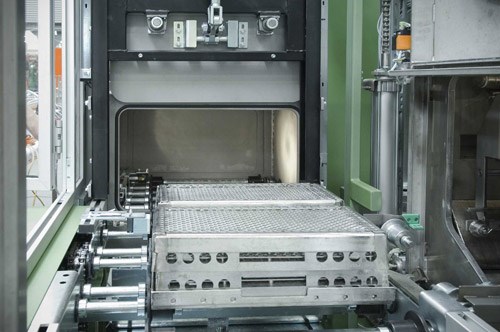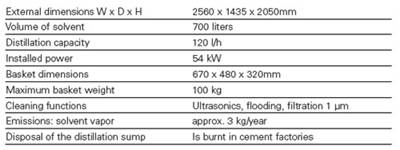The automotive industry views component cleanliness as a quality criterion, and requirements continue to get stricter with each generation of vehicles. Simultaneously increasing cost pressures have added to the importance of optimizing parts cleaning processes for automobile manufacturers and their suppliers.
Adding to the need for component cleanliness is the global push for reduced CO2 emissions and fuel consumption, as well as increased safety and comfort in automobiles. Downsized engines with high power yet better efficiency are in demand, as are tight-tolerance components that are capable of withstanding extreme loads. High precision components are required to meet these demands, and these can only be produced with increased sensitivity to contamination.
In the wrong place, even particles as small as 100 μm can cause damage and failure in the field. Therefore, the automotive industry has begun defining particle size distributions for certain parts in functional modules such as the power train, steering and brakes. To meet and document these requirements, some production applications require large investments in industrial parts cleaning technology. For example, based on calculations, the outlays required for cleaning technology that can fulfill a specified requirement of “no particles larger than 1,000 μm” are two to three times higher than for systems in which cleaned parts are contaminated with larger particles.
Minimizing Contamination
The parts cleaning process must be optimized economically, despite the large investment required for many applications. One approach is to begin with component design because the geometry of the workpiece and the individual steps of the manufacturing process (turning, milling, assembly, and so on), as well as cleanability, are determined at this time. Cleanability, though, often is overlooked during the design stage, which creates issues during the subsequent production process. The parts have corners, edges or drill holes from which particles and processing residues can only be removed with considerable effort, if at all.
Because chip-forming machining processes remove material, contamination can not be entirely avoided. The quality of the cooling lubricants and machining fluids used in the process influences the quantity of chips, burrs and particles on the workpieces. And with an effective purification/filtration process, contamination that is washed away cannot return to the component. An additional rinsing step within the machine tool, perhaps even with a more finely purified fluid from a separate tank, can further contribute to chip reduction.
While these efforts for contamination reduction create an additional initial expense, they pay for themselves throughout the manufacturing process with shorter cleaning times and longer bath service life, as well as better component quality. Also, residues that are removed after machining by means of mechanical pre-cleaning based on vibration, shaking, spinning or vacuum blasting the surfaces of the part do not place any unnecessary load on the cleaning agent.
In the case of multi-stage machining processes in metal forming and machining applications, intermediate cleaning steps prevent the accumulation of contamination, as well as any mixing or drying out of media on the workpieces.
Ideally Laid Out Cleaning Processes
Modern cleaning systems are capable of fulfilling even very high demands for component cleanliness – assuming the cleaning process has been ideally matched to the contamination to be removed, part geometry, the material and the cleanliness specification to be met.
To meet the requirements for components such as engines and gearboxes (typical limit values of less than 1,000 μm), the cleaning process needs to be laid out specifically for each part. Current technology uses a multi-stage procedure to effectively reach these specs. The workpieces are usually subjected to mechanical cleaning during the first step, removing some of the adhering machining fluid. The second step involves immersion flooding. Water is injected into the cleaning chamber below the surface of the bath at a pressure of 10 to 15 bar. The resulting whirlpool effect rinses chips and contamination out of hollow spaces such as threaded blind holes. Water jet systems that are aimed at openings in the component and lances that advance into holes allow for optimized results within short periods of time. This applies to subsequent, high-pressure cleaning or deburring, as well. Rinsing is followed by a drying process.
Numerous engine and gearbox variants, as well as ever shorter product life cycles, necessitate a great deal of flexibility, even for individual part cleaning. Automated cleaning solutions with robots that include options for easy reprogramming can be integrated into the production line to assure levels of flexibility that are comparable to those offered by machining centers.
Large numbers of vehicle parts are cleaned in batch processes as individually positioned items or bulk goods. Singleand multi-chamber systems that can be integrated into the production line are available for these cleaning tasks, as well. A modular design with various interlinking options assures adaptability to specific requirements, as well as expandability in accordance with actual needs.
In addition to the process technology and the medium that are used, the container also has a great deal of influence on the results and the economic efficiency of the cleaning process. There are two primary questions in this respect: Are the parts in the container readily accessible from all sides for the medium and the washing mechanism? Is it possible to position the part within the container such that critical areas can be treated in a targeted fashion? Efficient cleaning processes also require the removal of loosened contamination from the cleaning bath so that it is not redeposited on the parts. In order to assure continuous particle removal, gentle but constant bath motion is necessary along with effective filtration that is matched to the actual particle size.
Aqueous Medium or Solvent
Wet chemical cleaning processes with aqueous media or solvents are generally used in the automotive industry. Aqueous media, available as alkaline, neutral and acidic cleaners, are typically preferred in applications requiring the cleaning of very large volumes of parts or fine cleaning and micro-cleaning. Their cleaning effectiveness is based on an organic or an inorganic builder and tensides. The latter are able to “push” themselves in between the contamination and the material to be cleaned, dislodging non-polar contamination such as oil and grease, as well as polar contamination (emulsions, salts and particles). To achieve consistently good results, the bath must be continuously monitored and replaced at regular intervals.
Aqueous media are also used for rinsing processing oils from auto body parts prior to zinc phosphating. The industry offers specially developed products to reduce bath maintenance expenses, frequently accomplished through ultrafiltration. Through the use of demulsifying tensides, these products allow for the precipitation of oils introduced to the process, making it easier to remove them from the cleaning baths. Matched cleaning media are also available for the new, more environmentally compatible alternatives to zinc phosphating. They ensure the removal of oils on the components as well as oxides.
Chlorinated hydrocarbons (CHCs), the traditional degreasers, ensure especially effective degreasing and drying of metals – even for components with complex geometries. Particles that cannot be dissolved by the solvent, such as chips, are removed along with the oil because they are no longer able to adhere to the surface. Perchlorethylene has proven its worth for cleaning workpieces related to safety equipment, such as parts used in air bags, brake systems and power steering systems. Due to its chemical-physical characteristics, it is also frequently the solvent of choice when cleaning parts that have been joined by means of soldering or welding, such as components in cooling and air-conditioning systems, as well as electrical plug contacts.
Non-halogenated hydrocarbons (HCs) provide good dissolving performance for animal, vegetable and mineral oils and grease and demonstrate outstanding materials compatibility. Polar contaminations such as salts from emulsions cannot be removed with non-polar hydrocarbons.
Functional Surface Cleaning
Targeted cleaning of specific component surfaces such as seals, joints, bonds and laser welding areas can be the most effective method when dealing with cleanliness requirements that vary greatly on a single workpiece. In such cases where the high degree of cleanliness needed for the functional sur- face is not necessary for the entire part, conventional cleaning of the entire part with aqueous media or solvents can add high, unnecessary costs.
In the face of increasing cost pressure within the manufacturing processes used by suppliers to the automotive industry, functional surface cleaning, for example by means of CO2 snow jet, laser or plasma processes, provides a viable approach to saving both time and money. A further advantage offered by functional surface cleaning integrated into the production process is the fact that the cleaned surface is made available just-in-time, thus eliminating any need to implement measures targeted at maintaining cleanliness after cleaning and during transport.
Caution: Recontamination
As soon as the parts leave the cleaning system, recontamination becomes a concern. To prevent contamination of functionally critical components with particles from the environment, these parts can be inspected, packaged and stored in a clean zone, where personnel wear appropriate clothing and gloves.
In the automotive industry, functionally critical cleaned components are transported and stored in appropriate packaging. This packaging frequently consists of VCI foils, which at the same time offer corrosion protection. Part-specific, deep-drawn sheet materials are also used, which, like the small load carriers usually used for small parts (these are additionally lined with foil), must be cleaned at regular intervals. PC
Doris Schulz has worked as a freelance journalist for more than 15 years. Her specialty is the field of surface treatment, especially parts cleaning. She can be reached at 49 711 854085 or via e-mail at ds@pressetextschulz.de.













.png;maxWidth=300;quality=90)













